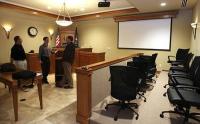
Built of cherry wood and designed from blueprints of courtrooms in the Matheson and West Jordan courthouses - the new $250,000 courtroom is not in any courthouse, but at the personal-injury law firm of Siegfried & Jensen.
"Jurors expect to see cases presented the way it is on television," said law partner Mitchell Jensen. "Instead of describing an accident, it is replayed for them."
At least one 3rd District Court judge is trying the technology. A LCD projector, screen and switchbox donated by LawMedia Center, which is building Siegfried & Jensen's system, were recently installed in Judge Paul Maughan's courtroom.
Maughan believes the equipment will allow for speedier and more efficient trials, while generating less paperwork, state courts spokeswoman Nancy Volmer said.
Prosecutors used the system earlier this month to display crime scene photos and other information during closing arguments in Floyd Eugene Maestas' capital murder trial.
"Nothing in Utah approaches this right now," said James McConkie, of Parker and McConkie, who recently partnered with Siegfried & Jensen. "It allows us to make a more powerful presentation in court."
"We can do a complete dry run of a trial," added law partner Ned Siegfried.
While jurors deliberate their verdict, attorneys can electronically eavesdrop to learn how they reached their decision. In an alcove at the rear of the mock courtroom, the firm has built what amounts to a small television production studio.
The equipment can be used to remotely depose a witness in another state, allow others to watch video depositions from elsewhere and to video-conference with other attorneys.
Lawyer Bradley Parker said the high-tech video depositions are more effective than paper depositions. The equipment can be used to incorporate video, photos, documents and diagrams into the deposition record.
"You can blow it up, highlight it and draw on it, just like they do during the Super Bowl," he said.
Another example: "If we catch a witness in a lie and sweat starts to form on his forehead, we can zoom in for a close-up," Parker said.
McConkie said the video equipment helped quickly settle the case of a woman who claimed her back was injured. The woman was being deposed when she was shown covert video of herself lifting a heavy set of barbells at a garage sale.
The television production equipment was also used in the case of a 5-year-old boy crippled at birth because of a lack of oxygen.
"We put together a settlement CD showing the baby walking and eating and running, sitting, putting on a shirt, and [the caregivers] settled before litigation began," McConkie said. "They could see what kind of client it was and how it would affect the jury," McConkie said.
Jensen said video helps humanize dead and injured clients. "It's hard to tell a story that's so personal without showing them," Jensen said. "It makes it personal. It's no longer a statement about an injury, it's a personal injury."









